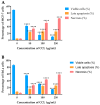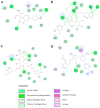Phytochemical Characterization and Anticancer Activity of Clerodendrum chinense Leaf Extract Against Breast and Cervical Cancer Cells
- PMID: 40141371
- PMCID: PMC11943097
- DOI: 10.3390/ijms26062729
Phytochemical Characterization and Anticancer Activity of Clerodendrum chinense Leaf Extract Against Breast and Cervical Cancer Cells
Abstract
Cancer remains a significant global health challenge, necessitating novel therapeutic interventions. Clerodendrum chinense leaf extract (CCL) has gained interest for its potential anticancer properties due to its bioactive composition. This study aims to evaluate the cytotoxic effects of CCL against MCF-7 breast cancer and HeLa cervical cancer cells and elucidate its mechanisms of action. High-performance liquid chromatography identified verbascoside, isoverbascoside, and hispidulin as the major bioactive compounds. CCL exhibited time- and dose-dependent cytotoxicity, with MCF-7 cells showing greater sensitivity (IC50 = 126.8 µg/mL, 72 h) than HeLa cells (216.1 µg/mL, 72 h). Flow cytometry confirmed apoptotic induction, with late apoptosis increasing at moderate concentrations (16.03-23.55%) and necrosis prevailing at higher doses (50.80-63.68%). Reactive oxygen species generation was significantly elevated in MCF-7 (70.2%) and HeLa (60.4%) cells at 250 µg/mL. CCL effectively suppressed colony formation and cell migration in a dose-dependent manner. Molecular docking studies demonstrated that apoptosis induction of CCL bioactive compounds may mediate through the pro-apoptotic BCL2 associated X, apoptosis regulator (BAX) regulator. These findings highlight the potential of CCL as a natural anticancer agent with multiple mechanisms, including reactive oxygen species (ROS)-induced apoptosis, BAX activation, and inhibition of proliferation and metastasis.
Keywords: Clerodendrum chinense; HELA; MCF-7; ROS; anticancer; apoptosis; verbascoside.
Conflict of interest statement
The authors declare no conflicts of interest.
Figures










References
MeSH terms
Substances
Grants and funding
LinkOut - more resources
Full Text Sources
Medical
Research Materials

